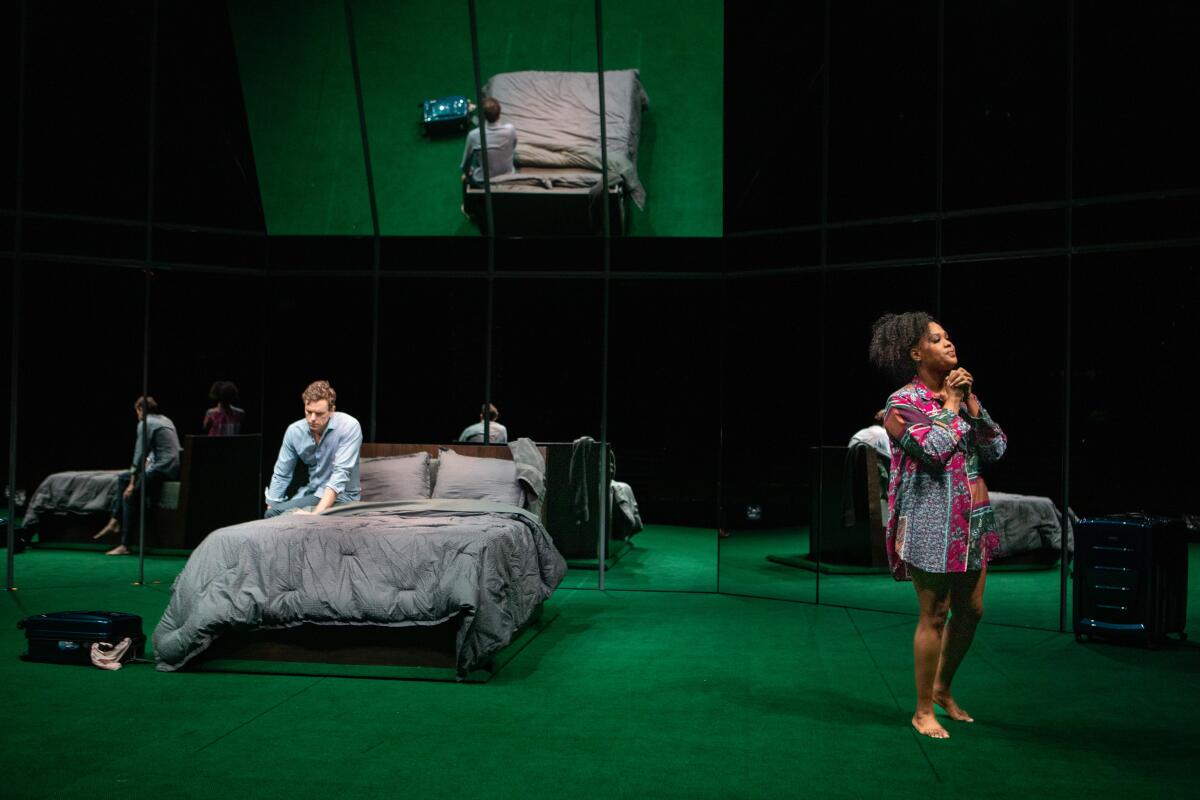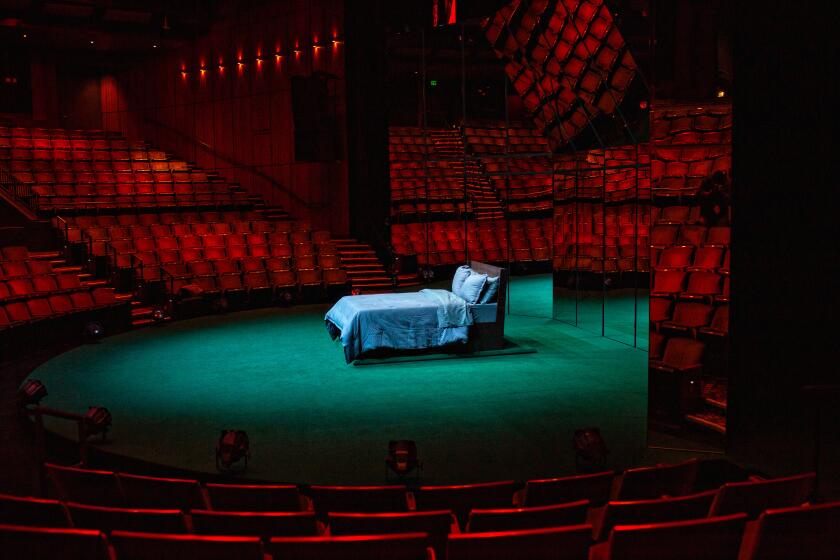Jeremy O. Harris’ ‘Slave Play’ awakens the Mark Taper Forum with a jolt

- Share via
No theatrical work in recent memory has had the seismic impact of Jeremy O. Harris’ “Slave Play.”
Harris was still a student at the Yale School of Drama when he wrote the play and had yet to graduate when the work had its off-Broadway premiere at New York Theatre Workshop in 2018. “Slave Play” moved the following year to Broadway, where it received 12 Tony nominations, the most ever for a play. Although it didn’t win any, the drama returned to Broadway for a second run that ended last month.
Harris didn’t just write “Slave Play.” He carved a path for its reception that threw out the white rulebook.
A statuesque Black queer playwright who moonlights as a fashion model and has a growing reputation as a screenwriter (“Zola”) and actor (“Emily in Paris”), Harris deployed his media presence to help make an explosive play about race and sexuality the most talked about, argued over and celebrated cultural phenomenon Broadway has seen in ages.
On Wednesday, “Slave Play” had its West Coast premiere at the Mark Taper Forum, reopening the theater with a jolt after a two-year pandemic interruption and inviting Los Angeles theatergoers to join a conversation that always seems to be maximally fraught.
The production, directed by Robert O’Hara (who has been so instrumental in the play’s success), uses the Taper’s thrust stage to connect more viscerally to the audience. The comedy plays more broadly than it did in New York, but the proximity of Clint Ramos’ reconfigured Broadway set draws us deeper inside the action.
Opening this week, the divisive show will be performed on a thrust stage — resulting in an immediate, exposed experience for both viewers and cast.
A backdrop of mirrors brings a heightened self-consciousness to spectators, who are denied their customary position of invisible voyeurs. We are all implicated in the intimate exchanges of the interracial couples who have gathered to probe the murky depths of their psyches.

The play, which takes place on a Southern plantation that has been co-opted for therapeutic purposes, is divided into three movements. The first involves a series of outlandish enactments between sexual partners exploring master-slave encounters of an antebellum kind.
Harris, much like Jackie Sibblies Drury in her Pulitzer Prize-winning 2018 play, “Fairview,” makes it intentionally difficult for theatergoers to find their footing. Anachronisms — like the blast of Rihanna’s “Work” that accompanies an enslaved woman as she sweeps and twerks — tip us off that the salacious historical recreations we are about to see are just that, a performance. But for whose pleasure is a question that will have to wait until the play’s second movement.
The middle section is the longest and, in some ways, the most challenging. The couples gather in a generic meeting room to “process” — a buzzword that’s used to satiric effect — what they discovered about themselves and their relationships through their role-playing.
Two researchers, Teá (Chalia La Tour) and Patricia (Irene Sofia Lucio), guide the group session, which is part of an experimental program they call “Antebellum Sexual Performance Therapy.” This treatment, they say, is “designed to help Black partners reengage intimately with white partners from whom they no longer receive sexual pleasure.”
The third movement zooms in on Kaneisha (Antoinette Crowe-Legacy) and Jim (Paul Alexander Nolan), the married couple who abandoned their sexual masquerade after Jim pulled the plug, leaving Kaneisha reeling with shame and betrayal. She had hoped the therapy would alleviate her numbness, but the only thing she feels is repulsion for her partner, who she now sees as harboring the “virus” of white supremacy.
“Slave Play” ends in a cauldron of emotions that are too historically fraught to lend themselves to catharsis. No surprise, then, that reactions to the play have been volatile.
One white woman who felt unfairly indicted by the play was captured on video during a Broadway talkback throwing a fit. A more trenchant line of criticism has come from Black women who have rejected the arc of Kaneisha’s journey. This critique has only intensified on social media during the play’s Los Angeles run.
Harris, as anyone who follows him on Twitter knows, is a polemicist who, for better or worse, doesn’t shy away from an internet tussle. “Slave Play” is meant to engender intense feelings. If the dramatic argument doesn’t always seem fair and balanced, the same can be said about American history. The work, radically centering Black lives (to adopt Teá’s language), is meant to be a corrective. But this doesn’t end the conversation.
As a white critic, I’ve appreciated the opportunity to listen not only to Black characters digging into difficult truths but also to the sound of my own silence. It’s not that I haven’t found myself arguing with “Slave Play.” But each time I’ve seen the work, I’ve had a different reaction, which to me is a sign of the work’s complexity.
Along with provocation, a fair amount of frustration is built into the dramaturgy. If you don’t accept the terms of the drama, you may find yourself mentally shouting into an abyss.
The waywardness of sexuality further complicates how the play is received. There’s a reason we don’t share our fantasies with our teachers, bosses and political representatives. Yet Freud wasn’t alone in recognizing that our histories, both private and collective, lurk in the background of our longings.
“Slave Play” reveals the way America’s racial past is inscribed on the body through both desire and the deadening of desire. To add nuance to a subject that could easily turn schematic, Harris explores a variety of relationship combinations on the spectrum of racial and sexual identities.
As designated in the script, Jim is a white, British-born man and Kaneisha is a dark-skinned Black southern woman. Phillip (Jonathan Higginbotham), a mixed-race man accustomed to being sexually objectified, is partnered with Alana (Elizabeth Stahlmann), a white woman who’s a few years older.
Gary (Jakeem Dante Powell), a dark-skinned Black man, is in a relationship with Dustin (Devin Kawaoka), who doesn’t identify as white but is perceived by others as being so. Teá and Patricia, who have their own communication issues, are mixed-race and light-brown-skinned women, respectively.
Identity for these characters isn’t simply an inheritance but an active negotiation. True intimacy requires that the characters feel the weight of a different history. The theory behind this not-yet-peer-reviewed therapy is that only through engaging the reality of race-based trauma can its damage be understood and possibly healed.
The middle section is the intellectual heart of the play. The psychological science is both lampooned and taken seriously. This doubleness is exciting, but sometimes the conceit of the group session feels overstretched.
At the Taper, Teá and Patricia ping-pong their jargon-y insights and politically-vetted instructions from the audience. La Tour and Lucio are “Slave Play” veterans, but the parody skids clumsily at moments. Patience, however, is rewarded as the emotional combustion in the room builds.
The chemistry of the actors is crucial in laying bare the characters’ relationship dynamics. Higginbotham’s Phillip and Stahlmann’s Alana shed disturbing light on the way love has come to confound the erotic bond of a couple who met on a fetish app.
Powell’s Gary and Kawaoka’s Dustin are stronger individually than they are together. In truth, they seem more like friends than intimate partners, though Gary’s emancipatory epiphany (“No ... I’m the prize, always have been, always will be”) lands with a punch.
Crowe-Legacy’s Kaneisha has a way of quietly making the earth quake as she sits with emotions she cannot yet express. Nolan, reprising his polished performance as Jim, is at his best when merely extending a gentle hand to the woman he loves but no longer knows how to reach.
A tentativeness has crept into the handling of the play’s ending, which has been the subject of much criticism. But the meaning of this violent conclusion nevertheless comes through. “Slave Play” ends not in exorcism (as the title of the third act would suggest), but in an exposure of the demons that have been hiding all along in plain sight.
'Slave Play'
Where: Mark Taper Forum, 135 N. Grand Ave., L.A.
When: 8 p.m. Tuesdays-Fridays, 2:30 and 8 p.m. Saturdays, 1 and 6:30 p.m. Sundays; ends March 13 (call for exceptions)
Tickets: $35-$110 (subject to change)
Information: (213) 972-4400 or centertheatregroup.org
Running time: 2 hours (with no intermission)
COVID protocol: Proof of full vaccination and booster is required. Masks are required at all times.
More to Read
The biggest entertainment stories
Get our big stories about Hollywood, film, television, music, arts, culture and more right in your inbox as soon as they publish.
You may occasionally receive promotional content from the Los Angeles Times.












